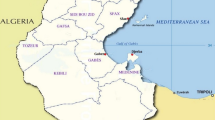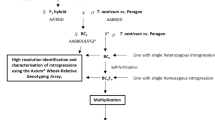Abstract
Grapevine is one of the most economically important fruit crops. Molecular markers have been used to study grapevine diversity. For instance, simple sequence repeats are a powerful tool for identification of grapevine cultivars, while amplified fragment length polymorphisms have shown their usefulness in intra-varietal diversity studies. Other techniques such as sequence-specific amplified polymorphism are based on the presence of mobile elements in the genome, but their detection lies upon their activity. Relevant attention has been drawn toward epigenetic sources of variation. In this study, a set of Vitis vinifera cv Pinot noir clones were analyzed using the methylation-sensitive amplified polymorphism technique with isoschizomers MspI and HpaII. Nine out of fourteen selective primer combinations were informative and generated two types of polymorphic fragments which were categorized as “stable” and “unstable.” In total, 23 stable fragments were detected and they discriminated 92.5 % of the studied clones. Detected stable polymorphisms were either common to several clones, restricted to a few clones or unique to a single clone. The identification of these stable epigenetic markers will be useful in clonal diversity studies. We highlight the relevance of stable epigenetic variation in V. vinifera clones and analyze at which level these markers could be applicable for the development of forthright techniques for clonal distinction.




Similar content being viewed by others
References
Rives, M. (1961). Bases génétiques de la sélection clonale chez la vigne. Annals of Amélior Plantes, 11, 337–348.
Pelsy, F. (2010). Molecular and cellular mechanisms of diversity within grapevine varieties. Heredity, 104, 331–340.
Carrier, G., Le Cunff, L., Dereeper, A., Legrand, D., Sabot, F., Bouchez, O., et al. (2012). Transposable elements are a major cause of somatic polymorphism in Vitis vinifera L. PLoS One, 7, e32973.
Riaz, S., Garrison, K. E., Dangl, G. S., Boursiquot, J.-M., & Meredith, C. P. (2002). Genetic divergence and chimerism within ancient asexually propagated winegrape cultivars. Journal of the American Society for Horticultural Science, 127, 508–514.
Pelsy, F., Hocquigny, S., Moncada, X., Barbeau, G., Forget, D., Hinrichsen, P., et al. (2010). An extensive study of the genetic diversity within seven French wine grape variety collections. Theoretical and Applied Genetics, 120, 1219–1231.
Cipriani, G., Spadotto, A., Jurman, I., Di Gaspero, G., Crespan, M., Meneghetti, S., et al. (2010). The SSR-based molecular profile of 1005 grapevine (Vitis vinifera L.) accessions uncovers new synonymy and parentages, and reveals a large admixture amongst varieties of different geographic origin. Theoretical and Applied Genetics, 121, 1569–1585.
Imazio, S., Labra, M., Grassi, F., Winfield, M., Bardini, M., & Scienza, A. (2002). Molecular tools for clone identification: The case of the grapevine cultivar “Traminer”. Plant Breed, 121, 531–535.
Laucou, V., Lacombe, T., Dechesne, F., Siret, R., Bruno, J.-P., Dessup, M., et al. (2011). High throughput analysis of grape genetic diversity as a tool for germplasm collection management. Theoretical and Applied Genetics, 122, 1233–1245.
Labra, M., Imazio, S., Grassi, F., Rossoni, M., & Sala, F. (2004). Vine-1 retrotransposon-based sequence-specific amplified polymorphism for Vitis vinifera L. genotyping. Plant Breed, 123, 180–185.
Blaich, R., Konradi, J., Rühl, E., & Forneck, A. (2007). Assessing genetic variation among Pinot noir (Vitis vinifera L.) clones with AFLP markers. American Journal of Enology and Viticulture, 58, 526–529.
Anhalt, U. C., Martínez, S. C., Rühl, E., & Forneck, A. (2011). Dynamic grapevine clones—an AFLP-marker study of the Vitis vinifera cultivar Riesling comprising 86 clones. Tree Genetics and Genomes, 7, 739–746.
Wegscheider, E., Benjak, A., & Forneck, A. (2009). Clonal variation in Pinot noir revealed by S-SAP involving universal retrotransposon-based sequence. American Journal of Enology and Viticulture, 60, 104–109.
Verriès, C., Bès, C., This, P., & Tesnière, C. (2000). Cloning and characterization of Vine-1, a LTR-retrotransposon-like element in Vitis vinifera L., and other Vitis species. Genome, 43, 366–376.
Kaeppler, S. M., Kaeppler, H. F., & Rhee, Y. (2000). Epigenetic aspects of somaclonal variation in plants. Plant Molecular Biology, 43, 179–188.
Paun, O., Bateman, R. M., Fay, M. F., Hedre, M., Civeyrel, L., & Chase, M. W. (2010). Stable epigenetic effects impact adaptation in allopolyploid orchids (Dactylorhiza: Orchidaceae). Molecular Biology and Evolution, 27, 2465–2473.
Richards, E. J. (2011). Natural epigenetic variation in plant species: A view from the field. Current Opinion in Plant Biology, 14, 204–209.
Fang, J.-G., & Chao, C. T. (2007). Methylation-sensitive amplification polymorphism in date palms (Phoenix dactylifera L.) and their off-shoots. Plant Biology, 9, 526–533.
Monteuuis, O., Doulbeau, S., & Verdeil, J.-L. (2008). DNA methylation in different origin clonal offspring from a mature Sequoiadendron giganteum genotype. Trees, 22, 779–784.
Schellenbaum, P., Mohler, V., Wenzel, G., & Walter, B. (2008). Variation in DNA methylation patterns of grapevine somaclones (Vitis vinifera L.). BMC Plant Biology, 8, 78.
Verhoeven, K. J. F., van Dijk, P. J., & Biere, A. (2010). Changes in genomic methylation patterns during the formation of triploid asexual dandelion lineages. Molecular Ecology, 19, 315–324.
Japelaghi, R. H., Haddad, R., & Garoosi, G.-A. (2011). Rapid and efficient isolation of high quality nucleic acids from plant tissues rich in polyphenols and polysaccharides. Molecular Biotechnology, 49, 129–137.
Schellenbaum, P., Walter, B. and Maillot, P. (2011) Is DNA methylation a marker of somaclonal variation induced by in vitro culture?, in Plant tissue culture and applied plant biotechnology, Editors Kumar, A. and Roy, S. Aaviskar Publishers, New Delhi, India: pp. 17–63 (ISBN: 9788179103630).
Fox, J. (2005). The R Commander: A basic-statistics graphical user interface to R. Journal of Statistical Software, 14, 1–42.
Botstein, D., White, R. L., Skolnick, M., & Davis, R. W. (1980). Construction of a genetic linkage map in man using restriction fragment length polymorphisms. American Journal of Human Genetics, 32, 314–331.
Marfil, C. F., Camadro, E. L., & Masuelli, R. W. (2009). Phenotypic instability and epigenetic variability in a diploid potato of hybrid origin, Solanum ruiz-lealii. BMC Plant Biology, 9, 21.
McKey, D., Elias, M., Pujol, B., & Duputié, A. (2010). The evolutionary ecology of clonally propagated domesticated plants. New Phytologist, 186, 318–332.
Meudt, H. M., & Clarke, A. C. (2007). Almost forgotten or latest practice? AFLP applications, analyses, and advances. Trends in Plant Science, 12, 106–117.
Pompanon, F., Bonin, A., Bellemain, E., & Taberlet, P. (2005). Genotyping errors: Causes, consequences and solutions. Nature Reviews Genetics, 6, 847–859.
Kalisz, S., & Purugganan, M. D. (2004). Epialleles via DNA methylation: Consequences for plant evolution. Trends in Ecology & Evolution, 19, 309–314.
Reinders, J., Wulff, B. B. H., Mirouze, M., Marí-Ordóñez, A., Dapp, M., Rozhon, W., et al. (2009). Compromised stability of DNA methylation and transposon immobilization in mosaic Arabidopsis epigenomes. Gene Development, 23, 939–950.
Richards, C. L., Bossdorf, O., & Verhoeven, K. J. F. (2010). Understanding natural epigenetic variation. New Phytologist, 187, 562–564.
Grativol, C., Hemerly, A. S., & Ferreira, P. C. (2012). Genetic and epigenetic regulation of stress responses in natural plant populations. Biochimica et Biophysica Acta, 1819, 176–185.
Vaughn, M. W., Tanurdžić, M., Lippman, Z., Jiang, H., Carrasquillo, R., Rabinowicz, P. D., et al. (2007). Epigenetic natural variation in Arabidopsis thaliana. PLoS Biology, 5, 1617–1629.
Feil, R., & Fraga, M. F. (2012). Epigenetics and the environment: Emerging patterns and implications. Nature Reviews Genetics, 13, 97–109.
Herrera, C. M., & Bazaga, P. (2010). Epigenetic differentiation and relationship to adaptive genetic divergence in discrete populations of the violet Viola cazorlensis. New Phytologist, 187, 867–876.
Lira-Medeiros, C. F., Parisod, C., Fernandes, R. A., Mata, C. S., Cardoso, M. A., & Ferreira, P. C. G. (2010). Epigenetic variation in mangrove plants occurring in contrasting natural environment. PLoS One, 5, e10326.
Yu, Y., Yang, X., Wang, H., Shi, F., Liu, Y., Liu, J., et al. (2013). Cytosine methylation alteration in natural populations of Leymus chinensis induced by multiple abiotic stresses. PLoS One, 8, e55772.
Becker, C., & Weigel, D. (2012). Epigenetic variation: Origin and transgenerational inheritance. Current Opinion in Plant Biology, 15, 562–567.
Schmitz, R. J., & Ecker, J. R. (2012). Epigenetic and epigenomic variation in Arabidopsis thaliana. Trends in Plant Science, 17, 149–154.
Feng, S., & Jacobsen, S. E. (2011). Epigenetic modifications in plants: An evolutionary perspective. Current Opinion in Plant Biology, 14, 179–186.
Reyna-Lopez, G. E., Simpson, J., & Ruiz-Herrera, J. (1997). Differences in DNA methylation patterns are detectable during the dimorphic transition of fungi by amplification of restriction polymorphisms. Molecular and General Genetics, 253, 703–710.
Xiong, L. Z., Xu, C. G., Saghai Maroof, M. A., & Zhang, Q. (1999). Patterns of cytosine methylation in an elite rice hybrid and its parental lines, detected by a methylation-sensitive amplification polymorphism technique. Molecular and General Genetics, 261, 439–446.
This, P., Jung, A., Boccacci, P., Borrego, J., Botta, R., Costantini, L., et al. (2004). Development of a standard set of microsatellite reference alleles for identification of grape cultivars. Theoretical and Applied Genetics, 109, 1448–1458.
Castro, I., D’Onofrio, C., Martín, J. P., Ortiz, J. M., De Lorenzis, G., Ferreira, V., et al. (2012). Effectiveness of AFLPs and retrotransposon-based markers for the identification of Portuguese grapevine cultivars and clones. Molecular Biotechnology, 52, 26–39.
Meneghetti, S., Calò, A., & Bavaresco, L. (2012). A strategy to investigate the intravarietal genetic variability in Vitis vinifera L. for clones and biotypes identification and to correlate molecular profiles with morphological traits or geographic origins. Molecular Biotechnology, 52, 68–81.
Meneghetti, S., Costacurta, A., Morreale, G., & Calò, A. (2012). Study of intra-varietal genetic variability in grapevine cultivars by PCR-derived molecular markers and correlations with the geographic origins. Molecular Biotechnology, 50, 72–85.
Acknowledgments
The authors would like to thank Jean-Michel Menant (ATVB) and Francis Minet (Pepinières Guillaume) for kindly providing the plant material used in this study, Dr. Najoi El Azhari (Welience) for technical support with the Li-Cor sequencer, Franck Fickinger-Villemin for MSAP technical assistance and Dr. Marc Lollier for the statistical part of the manuscript. This study was funded by the Fonds Unique Interministériel (FUI) and OSEO including a PhD grant for J. O.
Author information
Authors and Affiliations
Corresponding author
Rights and permissions
About this article
Cite this article
Ocaña, J., Walter, B. & Schellenbaum, P. Stable MSAP Markers for the Distinction of Vitis vinifera cv Pinot Noir Clones. Mol Biotechnol 55, 236–248 (2013). https://doi.org/10.1007/s12033-013-9675-3
Published:
Issue Date:
DOI: https://doi.org/10.1007/s12033-013-9675-3




